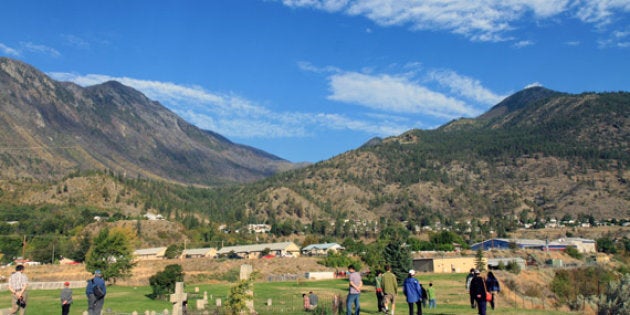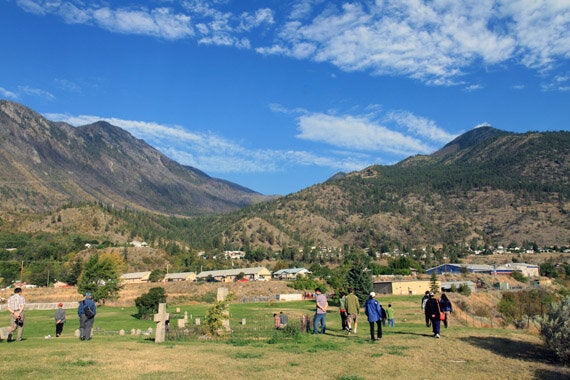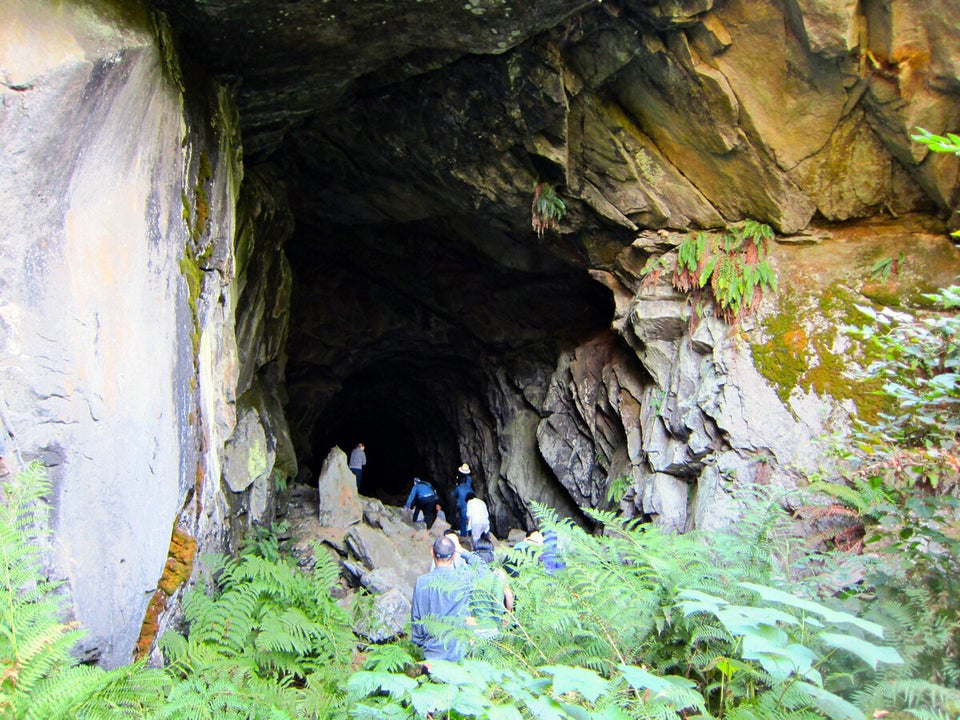
What a spectacle we were. The enormous bus roared down the highway, then slowed and pulled to the side of the road, kicking up gravel in its wake. When the dust settled, 47 of us stepped down from the bus, flashlights in hand. Some of us strapped on LED lights to our heads, as if we were gearing up for a spelunking tour. To explore a cave? No. A tunnel, yes. A tunnel so dangerous it was abandoned after too many Chinese railroad workers died trying to blast through the granite.
More than 130 years ago, some 17,000 Chinese railroad workers came here to British Columbia's Interior where they built bridges, roadbeds and tunnels through deep canyons and over wild rivers. They moved loads of rubble in pushcarts and on shoulder poles earning just $1 a day, half the amount made by fellow white railroad workers.
Many died ― crushed by rock slides and collapsing tunnels ― when blasting was done with nitroglycerin instead of the more expensive and stable TNT dynamite white workers used. White foremen made bets, gambling on whether or not Chinese labourers would escape the tunnels before the explosions went off. "Not a Chinaman's chance," the doubters would jeer.
I clambered up giant slabs of granite that had fallen in jagged piles and a dank, chilly breath washed over us as we ventured inside. We made it about 50 metres in before hitting a wall of rock. On this recent tour into the Fraser Valley, we visited forgotten places like that abandoned tunnel, a former gold mine where Chinese labourers once toiled, and an unmarked cemetery where Chinese pioneers were laid to rest.
In the valley, I discovered how two histories intersected ― how some First Nations people nursed railway workers back to health when they were left to die along the tracks, how First Nations men had teamed up with Chinese labourers working in a Nanaimo coal mine to fight off white bullies, and how some labourers had children with First Nations women.
"What's perceived as a marginalized group today had a deep relationship with the Chinese," said Bill Chu, our tour guide. "We need to restore the relationship with the indigenous people."

An immigrant from Hong Kong, Chu has been bringing busloads of mostly Chinese immigrants to native reserves to educate them about a history rarely shared. He has spent years advocating for what he calls "a fair and accurate depiction" of Chinese and First Nations history in the B.C. school curriculum. His group, Canadians for Reconciliation, is behind the push to get Premier Christy Clark to officially acknowledge the province's role in the discrimination and disenfranchisement of the Chinese.
But when he started on this mission 20 years ago, "it had nothing to do with Chinese at all," Chu said. "Two decades ago, it had everything to do with the indigenous people."
Chu first learned about Canada's First Nations one wintry day in 1988. He was a new immigrant then, shopping for green vegetables in Vancouver's Chinatown when "suddenly I heard someone say, 'Can I have some coffee money?'" Chu recalled. "I turned around and that was the first time I looked into the eyes of an aboriginal young person."
The two found a café on Hastings Street and Chu offered to buy the man some dinner. "He started telling me this strange, strange story about his miseries in a Manitoba reserve," said Chu, who was shocked to hear tales of such abuse. As a Christian, he tried to console the man by talking about God, but the man suddenly stood up and walked towards the door. "Just before he reached that door, he turned around and said: 'You are one of them!'"
Those words haunted Chu for years. What atrocities had taken place, he wondered, that would make a hungry man turn away his dinner? Two years after that encounter in Chinatown, Chu was eagerly following news of violent standoff in Quebec between members of the Mohawk First Nations and the Canadian military. In 1990, the town of Oka was planning to expand a golf course onto land traditionally used by the Mohawk as a burial ground. Photos of tanks and barricades and of a Mohawk warrior and Canadian solider facing off eye-to-eye sparked a flash of déjà vu for Chu.
Just a year earlier, he had been preoccupied with the demonstrations in Beijing's Tiananmen Square. He had organized a rally in Chinatown, where 600 people marched to show their support for the students. After the Chinese government ordered the tanks into the square, after thousands of students were massacred, Chu and 6,000 others attended a public memorial service just steps away from the Chinese consulate in Vancouver.
"That particular image [in Oka reminded me] of what we saw in Tiananmen Square a year before, when a column of tanks were approaching one, single Chinese fella," Chu said. "So the question to me at that point was: if you are so concerned about the people crushed in Tiananmen Square, shouldn't we also be concerned about the people to be crushed at Oka?"
Chu committed himself to learning about the plight of the First Nations and in doing so, discovered how the natives shared a common history with minorities like the Chinese. What a shock it was for Chu and for all of us on the tour, to see how these threads of history came together, to see how the story of the Chinese railroad pioneers could align with the history of Canada's First Nations and with the struggle for democracy in China.
At dusk near the town of Lillooet, on the side of yet another highway, we disembarked and trudged up a small hill overgrown with thirsty bushes and tall, yellowed grass. The Xaxli'p First Nations had erected a wiry fence to protect this small plot of land. Here lay the remains of Chinese labourers who stayed after the railroad was completed and worked on nearby tomato farms, Chu said. There were no signs or grave stones, just a rusty tin pail that lay in the brush.
"That's not your regular tin can," Chu said to us. "It's for burning incense." For centuries, the Chinese have lit incense to honour their ancestors, a tradition still carried on today. We all stared at that pail then -- red and tarnished after years of neglect yet enduring in the field for all of us to see. That weekend, I was among 47 Canadians who stopped to remember our past and acknowledge present injustices. Will more Canadians take the time to do the same?
